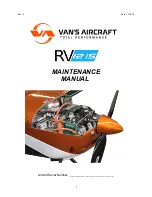
Serial Number 1646
48
observes and assesses the flight from ground. If no obvious piloting errors are observed, the instructor will allow the
other two flights forming this Lesson. Two-way radio communication between the instructor and the student is
recommended.
4.13
Lesson 14: Check traffic pattern flight
Training methodology:
Having passed the three solo flights forming the previous Lesson, the
instructor with the student fly
a check flight,
during which the instructor checks student’s piloting skills and habits. The instructor will draw attention to any piloting
errors, errors in altitude, traffic pattern shape, and/or any other deficiencies.
4.14
Lesson 15: Solo traffic pattern flight
Training methodology:
The student
flies 15 traffic patterns to strengthen the mastery of piloting skills and traffic pattern flying. Two-way
radio communication between the instructor and the student is recommended.
4.15
Lesson 16: Turns with bank angle 15 to 45º
Training methodology:
The student
repeatedly practices (solo) turns with bank angle 15 to 45º, finishing them at indicated bearings according
to compass, and flying figure-eights in free area, outside airfield, but under instructor’s supervision. Two-way radio
communication between the instructor and the student is recommended.
4.16
Lesson 17: Prevention of fall, glissade
Flight level is 1000ft / 300m AGL – 1600ft / 500m AGL.
Training methodology:
The student
repeatedly practices (solo) glissade and prevention of fall, in free area, outside airfield, but under
instructor’s supervision. Glissade practice as part of landing approach must be terminated at 170ft / 50m AGL. Two-
way radio communication between the instructor and the student is recommended.
4.17
Lesson 18: Planning of landing
Training methodology:
The student
repeatedly practices (solo) planning of landing at airport; on instructor’s signal, the student reduces engine
power to idle and plans landing to 1/3 of runway length, without further use of engine power.
The instructor
is
responsible for safe performance of this Lesson, taking into account the altitude, position of aircraft in traffic pattern,
wind speed and direction, the risk of overcooling the engine during descent, and airfield operating conditions. In case of
incorrect planning of landing, the student interrupts the approach, uses throttle and repeats the Lesson until it is
mastered. Two-way radio communication between the instructor and the student is recommended.
Conditions for passing:
The student
, on his own, plans landing to 1/3 of runway length, without further use of engine
power to correct angle of descent.
4.18
Lesson 19: 75 nm navigation flight
All conditions must be VFR.
Training methodology:
The instructor
defines flight route with landing at different airfield. A Triangular navigation flight with landing at two
different airfields is planned, with a Minimum flight distance
The student
performs complete navigation preparation
for the flight following assigned route.
The instructor
verifies navigation preparation and flies with the student,
without intervening in student’s piloting and/nor navigation, but accompanies the student for instruction. The student
must be able to fly safely and navigate at the same time while en route, during approach and landing at other airfield. In
case of loss of orientation and/or bigger deviations from planned route, this Lesson is failed. Fuel onboard must suffice
for planned flight and 20 more minutes.
4.19
Lesson 20: 75 nm navigation flight
One solo cross-country flight of at least 75 nautical miles total distance with a full-stop landing at a minimum of two
points and one segment of the flight consisting of a straight-line distance of at least 25 nautical miles between takeoff and
landing locations
Training methodology:
The instructor
defines flight route with landing at different airfields.
The student
performs complete navigation
preparation for the flight following assigned route, which is verified by the instructor. Fuel onboard must suffice for
planned flight and 30 more minutes.


































